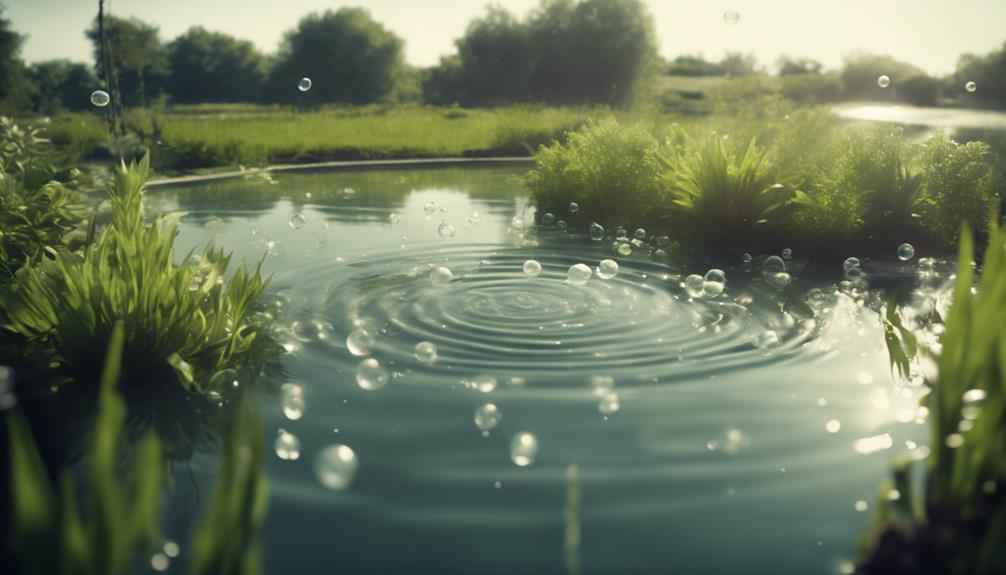You can destratify your pond and maintain a healthy aquatic environment by circulating oxygen-rich water from the surface to the bottom using aeration systems, which pump air into the water to increase oxygen levels throughout the entire water column. Without aeration, ponds can become stagnant, leading to low oxygen levels and an imbalance in the ecosystem. Aeration systems are beneficial in ponds with high levels of organic matter, helping to break down decaying material and reduce anaerobic zones. By installing an aeration system, you'll guarantee healthy and thriving water quality. Now, explore how to optimize your aeration system's design and operation for your pond's unique needs.
Table of Contents
Key Takeaways
- Artificial destratification through aeration systems eliminates thermal stratification, maintaining a stable and healthy aquatic environment.
- Aeration systems mix the water column, breaking down stratified layers formed due to temperature differences, and promoting uniform water temperature.
- By increasing oxygen levels throughout the entire water column, aeration systems reduce anaerobic zones and maintain a balanced ecosystem.
- Aeration prevents stagnation, reducing the growth of algae and aquatic weeds, and promoting a healthier environment for fish and aquatic plants.
- Proper aeration system design and operation ensure a thriving ecosystem, reducing unpleasant odors and maintaining healthy water quality and clarity.
Understanding Pond Aeration Systems
Pond aeration systems, which involve the circulation of oxygen-rich water from the surface to the bottom of a pond, play a crucial role in maintaining a healthy aquatic environment.
You may wonder how this process works. In effect, a pond aeration system pumps air into the water, increasing oxygen levels throughout the entire water column.
This circulation of oxygen-rich water has a profound impact on improving water quality. Without aeration, ponds can become stagnant, leading to low oxygen levels and an imbalance in the ecosystem.
By installing a pond aeration system, you can guarantee that your pond's water quality remains healthy and thriving.
Aeration systems can be particularly beneficial in ponds with high levels of organic matter, as they help to break down decaying material and reduce the risk of anaerobic zones.
Benefits of Artificial Destratification
By implementing artificial destratification, you can effectively eliminate the negative impacts of thermal stratification, which can lead to reduced oxygen levels, increased pH fluctuations, and decreased water circulation.
This process involves mixing the water column to break down the stratified layers that form due to temperature differences. As a result, you'll experience improved water aeration, which introduces oxygen-rich water into the deeper layers of your pond.
This oxygenated water helps to reduce the accumulation of decaying matter, promoting a healthier ecosystem.
With artificial destratification, you can also expect to see improved water quality and clarity.
The increased oxygen levels and enhanced circulation help to break down excess nutrients, reducing the growth of algae and aquatic weeds. Additionally, this process helps to maintain a stable pH level, which is essential for the well-being of aquatic life.
By destratifying your pond, you're creating a more balanced and thriving environment that supports the health and diversity of your aquatic ecosystem.
Key Features and Locations

When designing an artificial destratification system, you'll want to focus on key features and locations that optimize its performance.
You'll need to weigh the benefits of an aeration system and how it can enhance lake water circulation, which is critical for maintaining a healthy pond ecosystem.
Aeration System Benefits
You can reap numerous benefits from installing an aeration system in your lake, including increased water circulation and oxygen levels that promote a healthier environment for fish and aquatic plants. By reversing the conditions in your lake, with cooler water at the bottom and warmer water at the top, you can reduce algae growth and poor water quality. The increased oxygen levels also support a thriving ecosystem, allowing your aquatic life to flourish.
| Benefits | Description | Impact |
|---|---|---|
| Increased Water Circulation | Recirculates water between shallower and deeper layers | Reduces stagnation and promotes healthy ecosystem |
| Increased Oxygen Levels | Promotes healthy environment for fish and aquatic plants | Supports thriving aquatic life |
| Reduced Algae Growth | Reduces poor water quality and unsightly algae blooms | Enhances aesthetic appeal of your lake |
| Customizable Solutions | Different types and sizes of pond aerators available | Fits the unique needs of your waterbody |
With an aeration system, you can enjoy a healthier, more balanced ecosystem in your lake. By increasing water circulation and oxygen levels, you can create a thriving environment for your fish and aquatic plants to flourish.
Lake Water Circulation
Proper lake water circulation, achieved through strategic aeration system placement, is critical for maintaining a balanced and thriving ecosystem. You want to guarantee that oxygen is distributed evenly throughout the water column, from the surface to the bottom, to support aquatic life.
To achieve this, you'll need to ponder the key features and locations of your lake's water circulation.
When you aerate a pond, you create circulation patterns that help to:
Mix oxygen-rich water from the surface with oxygen-poor water at the bottom, reducing stratification and improving overall water quality
Disrupt thermal layers, allowing warmer water to mix with cooler water and reducing water temperature fluctuations
Increase water movement, which helps to prevent stagnation and reduce the growth of algae and aquatic weeds
Improving Pond Water Quality
When you improve water circulation in your pond, you'll notice a significant increase in oxygen levels, which is essential for maintaining a healthy aquatic ecosystem.
As oxygen levels rise, you can expect a reduction in carbon dioxide and alkalinity, leading to more stable pH levels.
Water Circulation Benefits
Circulating water throughout the pond basin enhances oxygen levels, reducing the likelihood of anoxic zones that can harbor anaerobic microorganisms, which degrade water quality. As you implement aeration systems, you'll notice improvements in your pond's water circulation. This, in turn, benefits the overall health of your pond.
Water circulation plays a vital role in maintaining healthy pond water.
- Reduced algae blooms: By circulating warmer water from the surface to the bottom of the pond, you reduce the likelihood of algae blooms. This helps maintain a balanced ecosystem and prevents the growth of unwanted aquatic plants.
- Prevents stagnation: Circulating water prevents stagnation, which can lead to the growth of anaerobic microorganisms. These microorganisms can produce harmful gases, further degrading water quality.
- Uniform water temperature: Water circulation helps maintain a uniform water temperature throughout the pond, reducing thermal stratification and promoting a healthier environment for aquatic life.
Oxygen Level Increase
By implementing pond aeration, you can substantially enhance oxygen levels throughout your pond, which is vital for maintaining healthy water quality and supporting the well-being of aquatic life.
As oxygen is essential for life in a body of water, increased oxygen levels provide a healthier environment for fish and aquatic plants. This, in turn, reduces unpleasant odors and algae growth, as oxygen-rich water inhibits the growth of algae spores.
Pond aeration also improves water quality by stabilizing pH, reducing alkalinity, and removing carbon dioxide, which leads to a shift from harmful blue-green algae to less-noxious green algae.
By circulating water between shallower and deeper layers, a pond aerator creates destratification of the water column, allowing oxygen-rich water to reach areas with lower dissolved oxygen. This enables fish to inhabit the entire lake, not just a certain stratified layer.
Enhancing Aquatic Ecosystems

Artificial destratification through aeration systems plays a pivotal role in enhancing aquatic ecosystems, as it effectively increases oxygen levels, improves water quality, and promotes a healthier environment for both fish and aquatic plants. By installing an aeration system in your pond, you're taking a key step towards creating a thriving ecosystem.
Aeration systems mix algae deeper into the water column, reducing sediment phosphorus load and promoting a balanced ecosystem.
The turbulence created in the conditioner of an aeration system increases the water-alloy contact ratio, subtly changing minerals and nutrients to benefit aquatic life.
Designing and Operating Systems
You must carefully evaluate several factors when designing an aeration system to guarantee it effectively destratifies your pond and meets the specific needs of your aquatic ecosystem.
This includes examining the pond's shape, size, and depth, as well as the water's oxygen levels, temperature, and circulation patterns.
You'll also need to weigh the type and number of aeration devices required, their placement, and the power source.
During winter, when water levels are low, it's crucial to direct the aerators towards deeper areas to maintain oxygen levels for winter fish.
Proper aeration system design and operation can also help eliminate foul odors caused by stagnant water and decaying organic matter.
By creating circulation and increasing oxygen levels, you can prevent the growth of anaerobic bacteria that produce these unpleasant smells.
Frequently Asked Questions
What Are the Disadvantages of Pond Aeration?
You should be aware that pond aeration has several drawbacks, including increased electricity costs, higher maintenance requirements, limited placement options in deep or complex ponds, and noise pollution that can disrupt the environment.
Does a Pond Aerator Really Work?
Imagine your pond as a stagnant, algae-ridden nightmare – but, trust us, a pond aerator isn't just a fancy gadget; it genuinely boosts pond health, water quality, and oxygen levels while being energy efficient, so yes, it really works!
Does Aerating a Pond Make It Clear?
You'll notice improved pond clarity as aeration increases water circulation, boosts oxygen levels, and reduces algae blooms, creating a healthier environment that supports aquatic life and enhances the overall aesthetic appeal of your pond.
How Much Does It Cost to Put an Aerator in a Pond?
When you're considering installing an aerator in your pond, you'll want to factor in installation costs, which can range from a few hundred to several thousand dollars, depending on system prices and aerator quotes, plus ongoing maintenance fees.
Conclusion
By incorporating a pond aeration system, you'll be breathing new life into your aquatic ecosystem.
With artificial destratification, you'll be releasing a tidal wave of oxygen and circulation, banishing stagnant water and revitalizing your pond's delicate balance.
By doing so, you'll be taking a pivotal step towards creating a thriving ecosystem, teeming with life and bursting with energy.
With the right design and operation, your pond will be transformed into a vibrant, self-sustaining haven, where aquatic life flourishes like never before.

